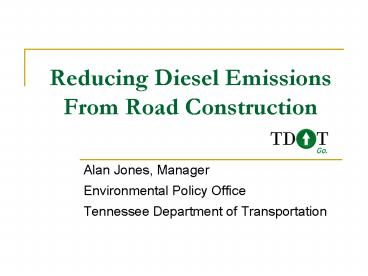Reducing Diesel Emissions From Road Construction - PowerPoint PPT Presentation
1 / 17
Title:
Reducing Diesel Emissions From Road Construction
Description:
17 counties in 8-hour ozone nonattainment* 9 counties in ozone Early Action Compacts ... Some counties nonattainment for both ozone and PM 2.5 ... – PowerPoint PPT presentation
Number of Views:38
Avg rating:3.0/5.0
Title: Reducing Diesel Emissions From Road Construction
1
Reducing Diesel EmissionsFrom Road Construction
- Alan Jones, Manager
- Environmental Policy Office
- Tennessee Department of Transportation
2
Contribution of Non-road Emissions
- NOx
PM 2.5
On-road mobile sources, e.g., cars,
trucks Area sources, including open
burning, small businesses, household
activities Source Tennessee 2002 Draft
Emissions Inventory
Point sources, e.g., factories and
utilities Non-road mobile sources, e.g.,
construction equipment, agricultural
equipment, lawn and garden equipment
3
Non-road Diesel EmissionsPM 2.5Percent
Contribution by Category
Diesel sources make up 73 of non-road emissions
from all fuels
Source Tennessee 2002 Draft Emissions Inventory
4
18 Nonattainment Counties in Tennessee
- 17 counties in 8-hour ozone nonattainment
- 9 counties in ozone Early Action Compacts
- 6 counties in PM 2.5 nonattainment
- Knoxville region (5 counties) and Chattanooga (1
county) - Some counties nonattainment for both ozone
and PM 2.5 - Note County totals include partial
county designations
5
TDOTs Clean Transportation Initiative
- Comprehensive effort to reduce on- and off-road
mobile source emissions - Reduce congestion (ITS, multimodal investments)
- Increase use of transportation alternatives and
reduce growth rate of VMT - Encourage cleaner fuels and vehicles(biofuels,
retrofits, etc.) - Partner with state/local governments, MPOs and
private sector on air quality projects
6
Clean Transportation Innovations Incentives Fund
- Dedicates up to 4.8 M (total FY 2005-2007) in
CMAQ Program funds - Partner with owners of heavy-duty diesels to
reduce emissions (existing fleets) - Project options include after treatment
(retrofits), replacement, repowering, rebuilding - Encourage idling reduction and cleaner fuels
- Public/private partnerships essential
7
Clean Transportation Innovations Incentives Fund
- Pilot projects for FY 2006
- Retrofit road construction equipment
- Retrofit public fleets
- School buses
- Transit vehicles
- Waste hauling vehicles
- City and county public works vehicles
- Idling reduction options for switchyard
locomotives - Develop competitive program for FY 2007
8
Congestion Mitigation and Air Quality Improvement
Program (CMAQ)
- Primary purpose improving air quality
- Transportation projects that reduce mobile source
emissions in nonattainment and maintenance areas - Non-federal match required (generally 20)
- State DOTs/MPOs - priority on diesel retrofits
and other cost-effective emission reduction
projects
9
CMAQ and SAFETEA-LU
- SAFETEA-LU authorized CMAQ to fund
- On-road and non-road diesel vehicles or
construction equipment projects - Outreach activities to diesel owners regarding
diesel retrofits - Primary project selection criteria
- Estimated emission reductions
- Cost-effectiveness of emission reduction
- EPA preparing guidance on cost-effectiveness of
CMAQ projects
10
TDOT Diesel Emissions Road Construction Pilot
- TDOT pilot project in East Tennessee aims to
- Assess feasibility and effectiveness of diesel
retrofits for construction equipment - Develop technical information to share with other
companies - Work with partner firms with existingor recently
awarded contracts in PM 2.5 nonattainment
counties
11
Road Construction Pilot - Announcement and
Applications
- TDOT identified firms now under contract
- Projects underway or recently awarded
- TDOT will announce the opportunity
- Partner firms will
- Inventory equipment for emissions rate, hours of
use, and remaining useful life - Identify specific equipment to retrofit
- Select verified retrofit technologies from EPA
list (e.g., diesel oxidation catalysts)
12
Project Selection and Public-Private Partnership
Agreements
- TDOT will
- Review applications and select projects to be
funded - Develop public-private partnership agreements
with successful applicants - Partner firms will
- Purchase and install technologybased on the
agreement - Send TDOT an invoice for 80 percentof project
costs
13
Partner Commitments
- Partner firms will
- Commit to use retrofitted equipment in
nonattainment area for limited period - Establish idling reduction policy
- Use low-sulfur fuel (lt500 ppm sulfur) with
oxidation catalysts or ULSD (lt15 ppm sulfur) with
particulate filters - Verify installation of retrofit devices and use
of cleaner fuel - Notify TDOT when equipment is removed from
nonattainment area
14
Reporting Requirements
- Partners will track actual equipment usage in
nonattainment area to verify emission reductions - Report amount of fuel consumed or number of
service hours for non-road equipment - Report miles traveled for each heavy-duty on-road
vehicle - TDOT will use EPAs retrofit calculator to
develop better estimates of expected emission
reductions
15
Insights and Issues
- Difficult for firms to make extended commitment
to keep retrofitted equipment in nonattainment
area - Because of replacement policies, larger companies
tend to use fairly new equipment - Greatest emission reductions from older engines,
especially unregulated engines - Earthmovers, large scrapers
- Large equipment rarely used in urban projects
(e.g., road widening, intersection improvements)
16
Insights and Issues
- Even with government cost-sharing, for-profit
companies are reluctant to incur added expenses - Incentives necessary to encourage participation
- Increased cost of cleaner fuels another barrier
- Must consider engine-specific information in
selecting the appropriate technology match - Older equipment a major issue
- Higher emissions
- Limited financial resources equipment owners
and funding opportunities
17
Needs and Opportunities
- Need for dedicated funding to share costs
- CMAQ may fund pilot projects, but other dedicated
funding sources are badly needed - Increased use of biodiesel
- Greater emphasis on idling reduction
- Future option - Contract bid specifications that
require use of cleaner equipment and cleaner
fuels - Raises costs of road projects when states already
face highway funding shortages































